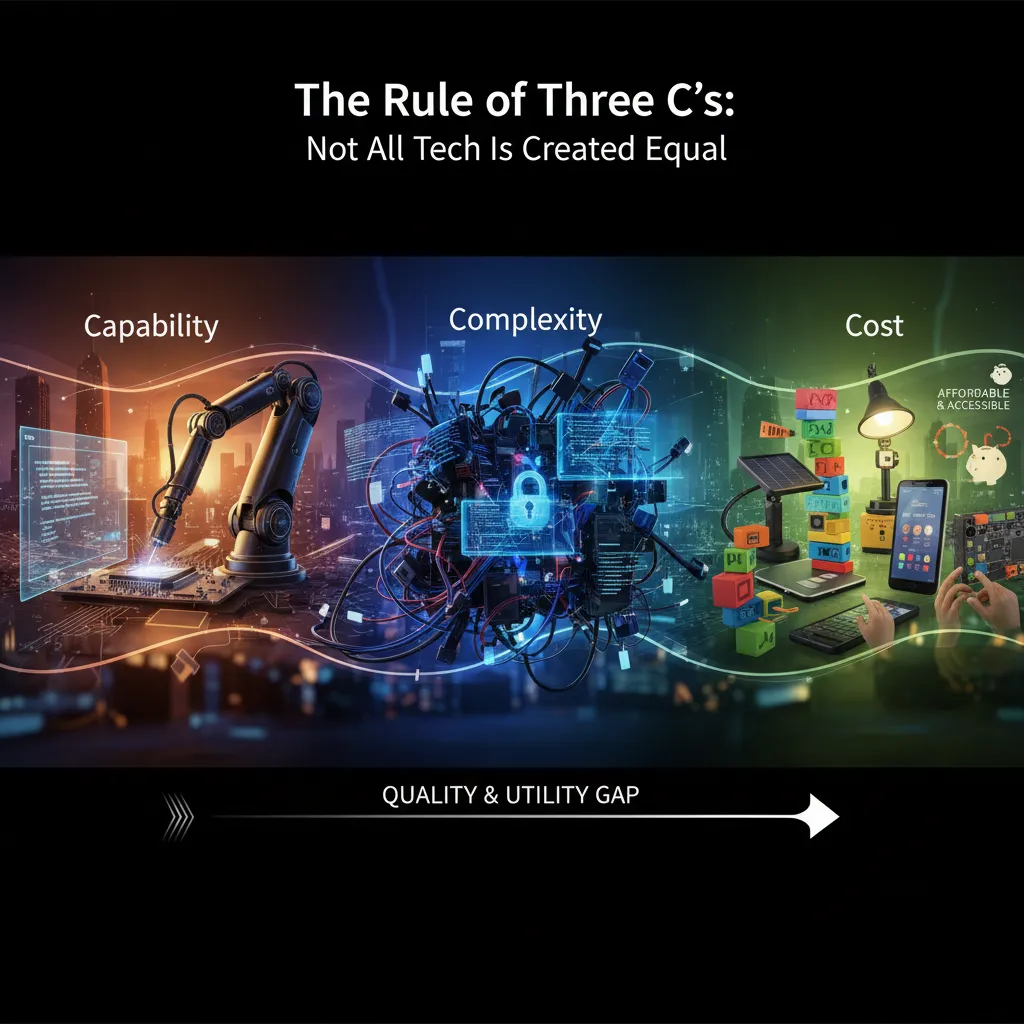Once, at a bustling airport, a stranger tapped me on the shoulder to ask which was the quickest security line. I didn't know—but I made a snap choice, and somehow, we both breezed through. That’s how life feels: a jumble of minuscule decisions adding up to our entire experience. The trick isn’t to agonize over every fork in the road, but to carry a toolkit of flexible mental models—each bright, useful, and sometimes weird—that filter noise and illuminate the smartest path. These aren’t the robotic routines of self-help books; they’re field-tested by real people who often break their own rules and learn as they go. Here’s what happens when you try these 10 quirky principles on for size.
1. The Rule of Three C’s: Not All Tech Is Created Equal
When it comes to decision making about technology, the Rule of Three C’s stands out as a practical mental model. This simple cognitive framework breaks down every tech purchase into three categories: Consume, Create, and Connect. Not all tech is created equal, and this model forces a pause—does a new gadget truly add value in one of these areas, or is it just another shiny distraction?
The Three C’s Mental Model Explained
- Consume: Does this device make it easier or more enjoyable to access the content you love? Think about the leap from paperbacks to a Kindle. Suddenly, thousands of books fit in your bag, and reading becomes frictionless.
- Create: Will this tool help you make something new? A laptop with a better keyboard or a high-quality camera can turn ideas into reality. The difference is clear—writing flows smoother, photos capture memories in vivid detail.
- Connect: Does this upgrade help you build or strengthen relationships? Sometimes, a new phone or app can make it easier to stay in touch, but often, the jump from one model to the next offers little real connection boost.
Forcing a Pause: Is It a Zero-to-One Upgrade?
The Rule of Three C’s is a cognitive framework that helps cut through the noise of endless tech releases. When a new gadget appears on the news or a YouTube channel, this model asks: Is this a zero-to-one upgrade, or just an incremental change? For example, buying a Kindle or a dedicated camera can be life-changing—suddenly, reading and capturing memories become effortless. In contrast, upgrading from an iPhone 10 to an iPhone 12 might only offer minor tweaks, not meaningful value.
Personal Anecdotes: Kindle Thrills and Camera Memories
Consider the thrill of a Kindle, which transformed reading habits overnight, versus the yawn of upgrading a phone for its own sake. Or the difference a real camera made in capturing university memories—photos that still spark joy, compared to forgettable phone snapshots. As one user puts it:
‘If you have a take on the 3C's, I decide cool, I probably want this piece of tech in my life. But if we don't, I think okay, this piece of tech is probably going to be a waste of time.’
By distilling tech decisions into consume, create, connect, this mental model ensures every purchase serves a purpose, not just a passing trend.

2. Hell Yeah or No: Ruthless Simplicity for a Crowded Calendar
Imagine your calendar as a garden. Every “yes” you plant is a seed, but not all seeds grow into something remarkable. This is where Derek Sivers’ “Hell Yeah or No” mental model steps in—a productivity rule that slices through tangled choices with ruthless simplicity. If a new opportunity doesn’t make you shout “hell yeah,” it’s a polite but firm “no.”
This approach to decision making is deceptively simple, yet profoundly effective. Most people, including seasoned decision-makers, find themselves defaulting to “yes” far too often. The invisible cost? A calendar overflowing with commitments that are just “okay”—leaving little time, energy, or attention for the rare, truly great things. As Sivers puts it:
‘By saying no to the merely good things, you’ll have time, energy, and space for the occasional great thing.’
Why We Say Yes Too Much
Humans are wired to please, to avoid conflict, and to keep options open. This leads to a crowded calendar and diluted focus. The regret is real: studies show that people frequently wish they’d declined more “meh” invitations and obligations. Every “reasonable” yes chips away at the space needed for something extraordinary.
Raising the Bar: A Mental Model for Productivity
The Hell Yeah or No rule is a dramatic filter for commitments. It’s a living, breathing decision matrix—one that weighs every new option against your gut reaction. If your response is anything less than enthusiastic, you simply say no. This isn’t about being harsh; it’s about protecting your most precious resource: time.
- Decision Making: Instantly clarifies what deserves your attention.
- Mental Models: Applies a high bar to every choice, inspired by Sivers’ philosophy.
- Productivity Rules: Frees up bandwidth for deep work, rest, and play.
Of course, even the most disciplined people struggle to follow this rule. The author admits to falling into the “reasonable yes” trap, filling their calendar with obligations that seemed harmless at first. But the act of trying—raising the bar, even imperfectly—can transform how you spend your days. When you filter for “hell yeah,” you make room for the great, not just the good.

3. Perfection is the Enemy: How Feedback Loops Trump Ideal Outcomes
Casey Neistat, the iconic filmmaker and YouTuber, once borrowed a mantra that has become gospel for creators everywhere: publish the imperfect, or you might publish nothing at all. This simple idea is more than motivational fluff—it’s a powerful mental model for decision making in complex systems. The truth is, perfectionism doesn’t just slow us down; it can stop us in our tracks.
Consider the story of over 1,000 students who joined the Part-Time YouTuber Academy. They all wanted to start and grow their channels, but more than 80% admitted to being stuck by ‘perfection paralysis.’ The most common roadblocks? Obsessing over the perfect camera, the ideal lighting, or flawless scripts. The result: endless tweaking, but no videos uploaded. As one instructor put it,
“To finish something even imperfectly is to learn from it—and then you can move on and get closer to perfection.”
This is where feedback loops come into play. In systems thinking, feedback loops are the engine of growth and improvement. When you act—upload a video, write a messy draft, launch a project—you get real-world feedback. That feedback becomes input for your next attempt, creating a cycle of learning and refinement. In contrast, chasing an ideal outcome in isolation means you never get the data you need to improve. You’re stuck in theory, not practice.
Personal struggles with writing highlight this dynamic. The urge to craft a New York Times bestseller from the first sentence can be paralyzing. But when the focus shifts to simply getting words on the page—no matter how messy—progress happens. Each draft, each revision, is a feedback loop in action. The imperfections reveal what works and what doesn’t, guiding the next step.
- Perfection blocks progress: Most creators stall not from lack of talent, but from waiting for ideal conditions.
- Feedback loops drive improvement: Real outcomes, not hypotheticals, are what refine skill and judgment.
- Action beats endless planning: Every upload, draft, or experiment is a step toward mastery—because it creates a feedback loop.
Letting go of perfection doesn’t mean settling for less. It means trusting the process: act, learn, adjust. In complex systems and creative work alike, feedback loops—not flawless beginnings—are what lead to unexpectedly intelligent decisions.

4. The Pareto Closet: 80/20 Thinking in Everyday Systems
Imagine opening a closet packed with clothes, yet reaching for the same handful of shirts every week. This isn’t just a quirk—it’s the Pareto Principle in action. Known as the 80/20 rule, it suggests that 20% of your inputs generate 80% of your results. Systems thinking reveals this pattern everywhere, from business profits to the tangled mess of a junk drawer.
Tim Ferriss, a champion of complex systems and efficiency, puts it simply: “
I realized I used two of them, so I donated the other 22 keyboards to a charity shelf.” Out of 24 keyboards at home, only two saw regular use. The rest? Dead weight, cluttering both space and mind. By identifying the MVPs—most valuable possessions—he cut through the noise, freeing up time and energy.
This isn’t just about tech. Inspired by Marie Kondo’s tidying wisdom, Ferriss applied the same logic to his wardrobe. He noticed that just 20% of his clothes got 80% of the wear. The solution was simple: donate or set aside the other 80%. The result was a closet in equilibrium—not static, but balanced, with only the essentials remaining.
Systems Thinking for Everyday Life
The magic of the 80/20 rule is its versatility. It’s a feedback loop for your entire life, not just your business. Here’s how systems thinking and the Pareto Principle can declutter more than just your closet:
- Wardrobe: Audit your clothes. Keep the 20% you actually wear. Donate the rest.
- Tech Gadgets: Count your devices. Which ones do you use daily? The rest can go.
- Digital Life: Unsubscribe from 80% of newsletters you never read. Focus on the few that matter.
- Time: Identify the 20% of tasks that drive 80% of your results. Prioritize ruthlessly.
In complex systems, equilibrium is rarely static. Our needs and habits shift, so regular self-audits keep things in balance. The Pareto Closet isn’t just about minimalism—it’s about clarity and feedback loops that help you focus on what truly matters, whether it’s hoodies, emails, or hours in your day.
5. Write-Off Days and Journey Mindsets: Messy, Marvelous Equilibrium
In the tangled web of complex systems that make up our lives, equilibrium is rarely a perfect, static balance. Instead, it’s a moving average—a messy, marvelous dance between productivity and pause, ambition and acceptance. One quirky but powerful mental model that helps maintain this dynamic equilibrium is the write-off day rule. Invented as a personal hack, this principle gives permission to declare a day a total loss—on purpose. No guilt, no productivity pressure, just a reset. Whether it’s a day spent playing video games, ordering takeout, or simply doing nothing, these 2-3 write-off days per month act as psychological pit stops. They relieve the guilt of “wasted” time and, paradoxically, refresh motivation and productivity for the days that follow.
This approach echoes the wisdom of First Principles Thinking: break down the problem of burnout to its roots, and you’ll find that rest is not a luxury, but a necessity for sustainable output. By accepting the ebb and flow of good and bad days, we create a more realistic and compassionate equilibrium—one that recognizes the value of imperfection.
Layered onto this is the mental model inspired by Brandon Sanderson’s The Stormlight Archive: Journey before Destination. As one character puts it,
“Every single day I’ll try my best to enjoy the journey, rather than being fixated on the destination.”This mindset flips the script on achievement. Instead of obsessing over goals—whether it’s writing a book, hitting a subscriber milestone, or getting six-pack abs—the focus shifts to the process itself. The journey is where we spend all our time; the destination is just a fleeting moment. By savoring daily progress, setbacks, and even stumbles, we keep our spirits high and our sense of meaning intact.
And when the path gets especially tangled, there’s always the wild card: Marie Forleo’s mantra,
“Everything is figure-outable.”This catch-all belief helps us roll up our sleeves and tackle the unknown, reinforcing the idea that no challenge is insurmountable.
In the end, embracing imperfection, making room for write-off days, and focusing on the journey rather than the finish line keeps life in a state of messy, marvelous equilibrium. It’s not about perfect balance—it’s about finding joy and resilience in the ongoing dance of complex systems and quirky mental models.
TL;DR: If you’re tired of overthinking, try a handful of practical mental models—they might just make decision making (and life) a whole lot lighter, messier, and more rewarding.



